The Bird Runner Art of Betsy Roe
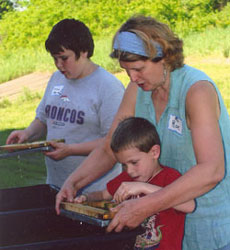
students how to make paper
from native plants at a
workshop hosted by Prairie
Heritage at the McDowell
Creek Community Center.
Much of artist Betsy Roe's work centers on the contact zone between humans and other animals. In "Passage," an installation created at Bird Runner in December 2011, that contact zone is a bloody one--the place where wild animals meet our vehicles on the road.
But what's the point? People aren't going to stop driving and animals aren't going to stop trying to cross the road. The situation is sad, sure-but why dwell on it?
Betsy's art has always taken on tough questions such as these.
"Passage" is the third in a series that Betsy created in honor of Jan Garton, whose ashes are scattered at the Refuge. Jan is credited with saving Cheyenne Bottoms, the wetlands in Barton County on which half the shorebird population of the western hemisphere depends. Without Jan, that hotspot of biodiversity would today be nothing but a cornfield.
What sort of memorial could be appropriate for such a person? Betsy knew that the usual monument and plaque were not going to work. She wanted natural materials-but more than that, she wanted to invoke actual natural processes. So for a location Betsy selected an old brome field that had recently been sown back to native. For materials, she cut down invasive dogwood that was encroaching on the tall grass prairie. She wove the stems into 27 statues, ranging in height from 3 to 30 feet and deployed in a spiral on the field. The figures are enigmatic. They remind visitors of something-goddesses, elders, mummies, captives, tipis, cyclones, infernos, wood sprites, sphinxes, funeral pyres, humans caught in the web of some giant wood-spinning spider--the associations vary, but everyone agrees on the figures' eery power. Betsy calls the statues "the gals" and invites visitors to adorn them with the seeds of native grasses and wildflowers. These seeds will germinate as the gals decompose. Visitors thus participate in prairie restoration--the particular healing process underway at this specific site. Here, where prairie restoration is the goal, the land is slowly breaking the bonds of enforced agricultural monoculture and reclaiming its identity as a self-regulating, self-expressive polyculture, once more a habitat where prairie creatures can survive. Betsy named this first phase of the memorial "Revival."
At the spring equinox last March, Betsy added the second phase. She asked volunteers to choose a place near the gals and lie down on the ground-like corpses. Then she poured the seeds of native wildflowers around them, outlining their shapes. She called this installation "Etain," for a Celtic figure of transformation. By June, wild gallardia and coreopsis were blooming where the motionless bodies once had been.
Then, as the winter solstice of 2011 approached, Betsy designed a third installment. She fashioned another "gal" adjacent to the first 27. This sculpture is also made of dogwood, but it has a headpiece that forms an open basket, bordered on all sides by upright branches, like Shiva's arms.
On December 22, Betsy gathered up a possum that had been killed on McDowell Creek Road and placed it within Shiva's arms. Reminiscent of ritual sacrifice, the act cast an ironic light on our society, which accepts the constant sacrifice of animals but denies that their deaths have any meaning.
"Passage" adds the missing sacredness. The bloody zone becomes a solemn zone, and once we enter it, we find we can think about what previously we just put out of our minds. Then small meanings spring up before us, like bread crumbs through the forest. Yes! There is something we can do. We can share the sacrifice, at least a little bit. We can sacrifice our hurry to drive more slowly; we can sacrifice our absentmindedness to watch more carefully; we can sacrifice our self-absorption to stop our cars altogether to help a still intact turtle, frog, or snake across the road.
And we can keep following that trail of meanings.
In fact, don't we use "roadkill" as a metaphor? Didn't Jan Garton keep Cheyenne Bottoms from becoming "roadkill"? -But then did she become "roadkill" herself?
Jan committed suicide in 2009. Why did she do it? Her heart was attuned to all living creatures, and yet she had to coexist with the extinction of one species after another. She was drawn to other women, body and soul, and yet she had to endure a state legislature that went out of its way, redundantly, to ban gay marriage-an act of gratuitous domination, not too different from the driver that swerves to hit an animal on the road.
Did tender-hearted Jan fall under those wheels?
I can hear her voice now, chiding me from the grave: " Margy, you've got it exactly wrong. I did what I did so I could stay in the driver's seat." Pace, Jan-I see what you mean. But, in addition, I can't help seeing that like so many of your fellow creatures, you couldn't live in a monoculture either. You may have looked around and seen that your habitat, too, was gone.
In its aerial crypt atop the statue, the possum killed by one of our machines was offered back to nature, to whatever scavenging eagle, raccoon, crow, possum, or coyote happened to accept the offer.
Human visitors wrote messages-often poems-which they added to the installation.
"Passage" thus allowed humans to offer to the animal dead what our society pathologically withholds-attention, appreciation, connection.
In addition, "Passage" invites us to ponder many passages--from autumn to winter, death to life, waste to use, impairment to health, indifference to reverence, estrangement to kinship-callous swagger to tender humility.
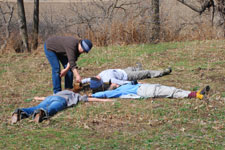
The ceremony 'Etain': Participants lie down on the ground like corpses and then Betsy outlines their bodies with native wildflower seeds.
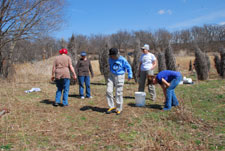
The group tamps down the seeds with their feet.
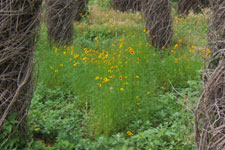
Wildflowers spring up where the bodies were
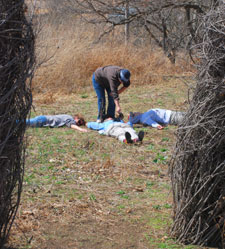
Pouring out the wildflower seeds
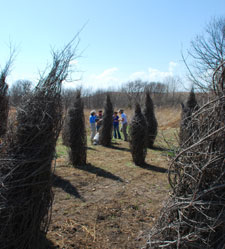
Tamping down the seeds
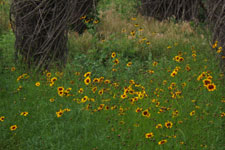
The site, transformed into wildflowers
